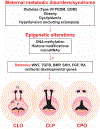Epigenetic implications in maternal diabetes and metabolic syndrome-associated risk of orofacial clefts
- PMID: 37497595
- PMCID: PMC11526419
- DOI: 10.1002/bdr2.2226
Epigenetic implications in maternal diabetes and metabolic syndrome-associated risk of orofacial clefts
Abstract
Orofacial clefts (OFCs) are one of the most common types of structural birth defects. The etiologies are complicated, involving with genetic, epigenetic, and environmental factors. Studies have found that maternal diabetes and metabolic syndrome are associated with a higher risk of OFCs in offspring. Metabolic syndrome is a clustering of several disease risk factors, including hyperglycemia, dyslipidemia, obesity, and hypertension. Metabolic disease during pregnancy can increase risk of adverse outcomes and significantly influence fetal development, including orofacial formation and fusion. An altered metabolic state may contribute to developmental disorders or congenital defects including OFCs, potentially through epigenetic modulations, such as histone modification, DNA methylation, and noncoding RNA expression to alter activities of critical morphogenetic signaling or related developmental genes. This review summarizes the currently available evidence and underlying mechanisms of how the maternal metabolic syndrome is associated with OFCs in mostly human and some animal studies. It may provide a better understanding of the interactions between intrauterine metabolic status and fetal orofacial development which might be applied toward prevention and treatments of OFCs.
Keywords: diabetes; dyslipidemia; epigenetics; hypertension; maternal metabolic syndrome; obesity; orofacial clefts.
© 2023 Wiley Periodicals LLC.
Conflict of interest statement
CONFLICT OF INTEREST STATEMENT
The authors declare no conflict of interest.
Figures

Similar articles
-
Maternal Metabolic Status and Orofacial Cleft Risk: A Case-Control Study in Thailand.Int Dent J. 2024 Dec;74(6):1413-1423. doi: 10.1016/j.identj.2024.02.005. Epub 2024 Apr 12. Int Dent J. 2024. PMID: 38614877 Free PMC article.
-
Maternal obesity is a risk factor for orofacial clefts: a meta-analysis.Br J Oral Maxillofac Surg. 2015 Oct;53(8):699-704. doi: 10.1016/j.bjoms.2015.05.017. Epub 2015 Jun 12. Br J Oral Maxillofac Surg. 2015. PMID: 26073906
-
Gene×environment associations in orofacial clefting.Curr Top Dev Biol. 2023;152:169-192. doi: 10.1016/bs.ctdb.2022.10.006. Epub 2022 Nov 14. Curr Top Dev Biol. 2023. PMID: 36707211 Review.
-
Role of epigenetics and miRNAs in orofacial clefts.Birth Defects Res. 2020 Nov;112(19):1635-1659. doi: 10.1002/bdr2.1802. Epub 2020 Sep 14. Birth Defects Res. 2020. PMID: 32926553 Free PMC article. Review.
-
Cellular and developmental basis of orofacial clefts.Birth Defects Res. 2020 Nov;112(19):1558-1587. doi: 10.1002/bdr2.1768. Epub 2020 Jul 29. Birth Defects Res. 2020. PMID: 32725806 Free PMC article. Review.
Cited by
-
The Role of Helicobacter pylori and Metabolic Syndrome-Related Mast Cell Activation Pathologies and Their Potential Impact on Pregnancy and Neonatal Outcomes.J Clin Med. 2024 Apr 18;13(8):2360. doi: 10.3390/jcm13082360. J Clin Med. 2024. PMID: 38673633 Free PMC article. Review.
-
Maternal Metabolic Status and Orofacial Cleft Risk: A Case-Control Study in Thailand.Int Dent J. 2024 Dec;74(6):1413-1423. doi: 10.1016/j.identj.2024.02.005. Epub 2024 Apr 12. Int Dent J. 2024. PMID: 38614877 Free PMC article.
-
Global, regional, and national burden of orofacial clefts, 1990-2021: an analysis of data from the global burden of disease study 2021.Front Med (Lausanne). 2025 Jun 11;12:1609700. doi: 10.3389/fmed.2025.1609700. eCollection 2025. Front Med (Lausanne). 2025. PMID: 40568198 Free PMC article.
-
Maternal factors increase risk of orofacial cleft: a meta-analysis.Sci Rep. 2024 Nov 15;14(1):28104. doi: 10.1038/s41598-024-79346-7. Sci Rep. 2024. PMID: 39548204 Free PMC article.
References
-
- Alba-Linares JJ, Perez RF, Tejedor JR, Bastante-Rodriguez D, Ponce F, Carbonell NG, . . . Lurbe E. (2023). Maternal obesity and gestational diabetes reprogram the methylome of offspring beyond birth by inducing epigenetic signatures in metabolic and developmental pathways. Cardiovasc Diabetol, 22(1), 44. doi:10.1186/s12933-023-01774-y - DOI - PMC - PubMed
Publication types
MeSH terms
Grants and funding
LinkOut - more resources
Full Text Sources
Medical

